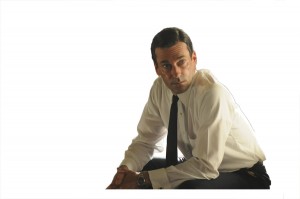Mad Men demonstrates television’s nostalgia for the past
It was the first cable show to take home the Emmy for outstanding drama series three years in a row and last September, Mad Men did it again. It sired a wave of nostalgia that one backward-facing period drama after another hoped to ride into the ratings’ promised land.
The show’s ratings are by no means modest for cable — its season five premiere Sunday reached 3.5 million, the highest ratings in the show’s history — but to put that in perspective, a typical episode of American Idol for this season reaches around 20 million viewers. Mad Men might never have the mass appeal required to sustain an audience on one of the major broadcast networks, but the show enjoys a measure of cultural significance that arguably no other television program comes close to rivaling.
Even if Mad Men never breaks the double-digits in terms of the millions of eyes tuning in on Sundays, there’s no denying that the show is a certifiable trendsetter. In the wake of its fanatically anticipated two-hour return — if ever there were a case of absence making the heart grow fonder, this was it — it’s hard not to consider what, if anything, Mad Men is doing with all its cultural power.
Surely Mad Men’s greatest contribution to the pop cultural landscape is the rash of “retrophilia” that the show inspired in fans when it burst onto the scene in 2007. Roughly around the time Mad Men began edging its way into America’s heart, a national fascination with bygone eras — the 1960s, in particular — manifested in decisions ranging from outfit choices to TV programming schedules.
Credit for the long-overdue revival of interest in classic cocktails has to be given at least in part to the boozy workplace environment depicted in the show. What Sex and the City did for the Cosmo, Mad Men did for just about everything stiffer. To some extent, sartorial choices not just on the runway but also in fans’ day-to-day wardrobe choices began to reflect the style, sophistication and level of care suggested by Mad Men costume designer Janie Bryant’s impeccable attiring of characters on the show.
Studio executives have also gotten swept up in the flurry of whiskey-tinged nostalgia: We’ll never know exactly what was said in the pitch meetings for shows like Pan Am and the ill-fated The Playboy Club, but there isn’t the feeblest doubt in my mind that Mad Men was mentioned as a reference point when the idea for those sorts of retro-glamorous shows were being sold to ABC and NBC, respectively.
Considering its setting in the 1960s, Mad Men has taken some flack for its typically superficial engagement with the premier social issue of the day, segregation.
Don Draper’s (Jon Hamm) interaction with a black waiter named Sam in the first scene of the pilot episode seemed to suggest that race would play a justifiably large role in the historically set series, but the coming seasons failed to make good on the implicit promise: When the show has touched on race relations in the past, it’s typically been only in passing.
Creator and executive producer Matthew Weiner most likely made the creative choice to focus on his characters, rather than the socio political climate, early in the execution of his concept — and the decision is more than defensible.
The complexities of the show’s ever-changing romantic relationships, workplace dynamics and sexual politics are sufficiently engaging to keep audiences tuning in without the added gimmick of the 1960s. In many episodes, the time period feels almost incidental to the timelessness of the human drama that plays out every week.
As New York Magazine TV critic Matt Zoller Seitz put it, “The show’s main draw is behavior, observed with such exactness that one can imagine the show’s being transposed to the forties or eighties, with different clothes, slang and inebriants, but still delivering the same basic satisfactions.”
And Mad Men has delivered those “same basic satisfactions” almost unfailingly for four seasons now. But to continue with only the infrequent obligatory nod to the realities of life in the 1960s would be to bury in the sand the head of a smart show that prides itself on incisiveness.
That’s why Sunday’s season five premiere, bookended as it was with scenes addressing the way in which the simmering tensions of the civil rights movement began to come to a head in the later 1960s, was particularly promising. The series seems poised to tackle issues that it has largely skirted around in the past.
For a show as influential and trendsetting as Mad Men is, what it chooses to represent on-screen is almost a political move. If the pervasiveness of retro-fever for the ’60s is any indication, Mad Men packs quite a punch in setting the pop cultural agenda. Fedoras off to Mad Men for making good on the responsibility that comes with that amount of cultural clout.
Louis Lucero II is a senior majoring in environmental studies. His column “Small Screen, Big Picture” runs Thursdays.
